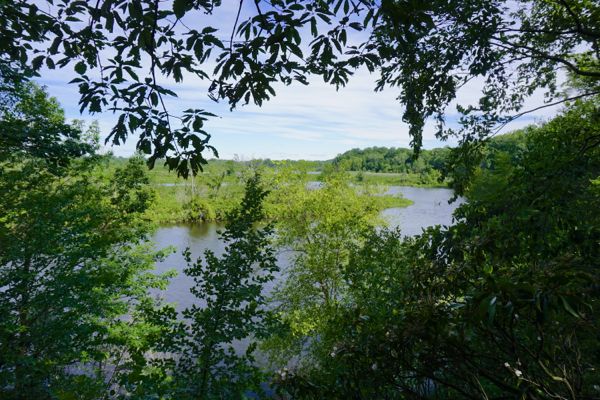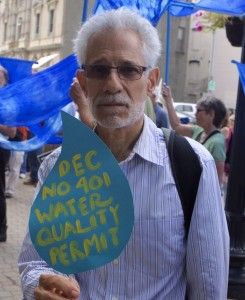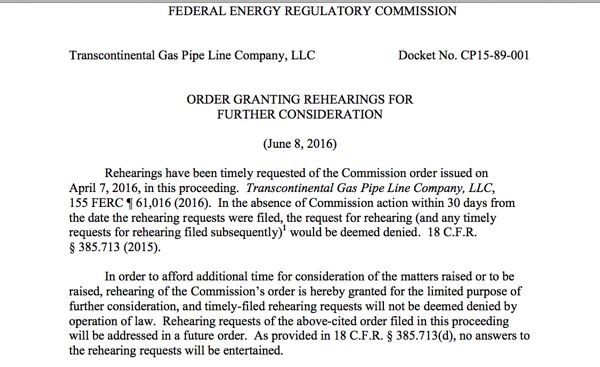Another Reason Legislature Must Veto DEP Rule As Inconsistent with Legislative Intent
What explains the lack of criticism of this vast expansion of DEP regulation?
Most of the debate on the pending Legislative veto of the Christie DEP’s proposed rollback of the Flood Hazard, storm water, and coastal management rules has properly focused on how the new DEP rule would allow more development in sensitive protected stream buffers and thereby reduce water quality and increase flooding risk, contrary to legislative intent to protect and restore water quality and reduce flood risks.
With respect to rolling back protections for stream buffers, the DEP rule would:
1) repeal the current prohibition on disturbance of soils and vegetation of the inner buffer, within 150 feet of exceptional “Category One” (C1) streams;
2) make it easier to get a hardship waiver from regulatory standards, including the current prohibition;
3) eliminate the current requirement to demonstrate “equivalent protection” for disturbance of soils and vegetation in the outer buffer, between 150 – 300 feet of C1 streams;
4) increase current allowable disturbance and development in buffers;
5) eliminate buffer protections for certain headwater streams that lack a defined stream bed and bank; and
6) allow mitigation, when it is “not feasible” to meet the standards for allowable disturbance, thereby making a sham of the current prohibition on disturbance and bypassing the current standards to limit allowable disturbance.
No need to take my word for it – the DEP admits all this in the proposal itself in many places, but this text on page 59-60 sums it all up:
Therefore, while N.J.A.C. 7:8-5.5(h) prevents certain types of new development from occurring within SWRPAs, the FHACA Rules recognize that development within riparian zones is sometimes unavoidable, and therefore establishes requirements necessary to ensure that disturbance to riparian zone vegetation is avoided where feasible, minimized to the extent practicable, and, where disturbance to riparian zone vegetation would adversely impact the environment, appropriate compensation is provided in order to ensure the continued preservation and/or improvement of riparian zone functionality. In instances where development is indeed unavoidable, the Department is required to issue a hardship exception to allow the applicant to proceed. The Department has therefore determined that these amendments are appropriate to allow certain unavoidable development, subject to the standards set forth in the amended rules, rather than require the applicant to undertake the burden of applying for a hardship exception.
But, aside from the buffer rollbacks, a significant issue has been drown out and gotten virtually no attention.
The DEP rules create a complex new “riparian mitigation bank” and riparian credit trading scheme.
The DEP creates this major new regulatory policy and program out of whole cloth – based on the Freshwater Wetlands Act, where the Legislature has authorized a regulatory program for wetlands mitigation banking which is overseen by the Legislatively created Wetlands Mitigation Council:
As described in the rules, the operator of a Department approved mitigation bank is allowed to conduct activities that result in increased values and functions of the resource protected by the rules allowing for the mitigation bank on property owned by the mitigation bank operator and subsequently sell mitigation credits in an amount and according to a schedule approved by the Department to developers of projects within a specified area to satisfy mitigation requirements applicable to that project. The Department currently allows individuals to engage in wetland mitigation banking to provide a mitigation alternative for impacts to freshwater wetlands and coastal wetlands and is proposing to similarly allow the creation of riparian zone mitigation banking, as well as the use of riparian zone mitigation bank credits. (DEP proposal at p. 129-130).
But riparian zones are not wetlands.
Ordinarily, such a vast expansion of DEP regulatory authority – especially by creating costly new requirements that amount to a tax or surcharge on new development – would be hotly debated and strongly opposed by the NJ Builders Association and similar development interests, as well as other interested parties and policy experts (e.g. the Chamber of Commerce, NJ BIA, NAIOP, landowners, real estate speculators, banks & development finance institutions; right wing opponents of DEP regulatory power; left wing opponents of market trading schemes; scientists and ecologists who oppose mitigation because it does not work (something even DEP admitted); NJ Legislators and lawyers who honor Constitutional principles of separation of powers issues, etc).
But amazingly, there has been no opposition! None. What explains that silence?
We think that the builders and development community are getting such huge regulatory relief that they are willing to pay a small amount in mitigation fees, which will be a tiny drop in the bucket compared to the “regulatory certainty” (a green light from DEP) and increased profits from more lucrative development closer to the water where it is currently prohibited.
On top of the controversial policy debate that would ensue if DEP proposed such a stand alone regulation, the DEP lacks authorization by the Legislature to even adopt such a controversial regulatory scheme.
So, where is the NJ Environmental Law Bar to object to that flagrant legal abuse? (especially in light of the recent Appellate Division opinion striking down DEP’s public access rules for lack of legislative authority. Those rules had been implemented for over 25 years, while the DEP’s riparian trading scheme is brand new.)
In addition to my prior comments on the DEP rule proposal and testimony to the Legislature, I fired off this letter to Senate Environment Committee Chairman Smith, who seems to be waivering (pun intended) in following through on the Legislative veto threat:
Dear Chairman Smith:
During last week’s hearing on SCR 66 (veto of DEP Flood Hazard rules), one of the issues I raised again was a lack of legislative authorization for DEP to create a riparian mitigation bank.
In contrast to this lack of authority (express or implied), there is clear enabling authority for mitigation banking in the NJ Freshwater Wetlands Protection Act, upon which the DEP riparian banking scheme is modeled.
The Legislature fully understands the need for authorization of trading schemes. In addition to the Freshwater Wetlands Act, the Legislature has authorized various forms of trading schemes in the Highlands Act, Pinelands Act, RGGI, and TDR legislation, but has not done so in the Flood Hazard Control Act or other authority DEP relies on for the rules in question.
Logically, if there is no Legislative authorization, the DEP rules must be “inconsistent with legislative intent“, as well as ultra vires.
I call to your attention how DEP responded to that criticism in the adoption document for the rule. Below I excerpted the complete text of my comment (#729) and the DEP response.
As you will note, DEP did not cite a specific legislative provision that would authorize the regulatory mitigation banking scheme they just adopted. The case law DEP cited is not on point. (DEP text in italics).
See page 617 – 619
http://www.nj.gov/dep/rules/adoptions/adopt_2016xxxxa.pdf
729.COMMENT: The proposal includes a new Subchapter 13, Riparian Zone Mitigation, which is broad in scope and significant in substance, both economically and environmentally. A change in regulatory policy of this magnitude requires express statutory authorization by the Legislature. The FHACA does not authorize the Department to create a mitigation scheme or a mitigation bank. The act does not specifically or implicitly provide for a mitigation program or a mitigation bank, nor does any other authority the Department relies on as the legal basis for the proposal. However, the act does establish clear legislative standards and authorizes the Department to enact regulations to enforce those standards via a traditional regulatory permit program. Because the proposed program is a radical departure from the Department’s traditional regulatory policy and practice, the proposal isultra vires, legislatively unauthorized, and contrary to the express framework and provisions of the act. The mitigation scheme and mitigation bank are also inconsistent with legislative intent. The proposal must be withdrawn. (193)
DEP RESPONSE TO COMMENTS 728 and 729: While the Flood Hazard Area Control Act is the primary enabling legislation for the Flood Hazard Area Control Act Rules, the rules are also adopted under the authority of the Water Pollution Control Act (N.J.S.A. 58:10A-1 et seq.), the Highlands Water Protection and Planning Act (N.J.S.A. 13:20-1 et seq.), the Water Quality Planning Act (N.J.S.A. 58:11A-1 et seq.), and the Ninety Day Construction Law (N.J.S.A. 13:1D-29 et seq.).
The Department’s ability to protect the environment, including flora and fauna, as it implements the Flood Hazard Area Control Act Rules, was affirmed by the Appellate Division Court in 1985 (see Society for E.E.D. v. New Jersey DEP, 208 N.J. Super. 1 (App. Div., 1985)). In addition, the Department’s authority to use stream buffers to protect water quality was affirmed in In the Matter of Stormwater Management Rules, 384 NJ Super. 451, cert. denied 188 NJ 489 (2006). Taken together, these authorities vest the Department with broad discretion to promulgate these rules to address flooding, protect water quality, provide protection of natural resources, and to protect public health and safety. It is well documented that vegetation adjacent to surface waters is essential for maintaining bank stability and water quality. The indiscriminate disturbance of such vegetation destabilizes the shorelines of surface waters, which leads to increased erosion and sedimentation that exacerbates the intensity and frequency of flooding. The loss of vegetation adjacent to surface waters also reduces filtration of stormwater runoff and subjects surface waters to increased sun exposure, which causes water temperatures to rise and dissolved oxygen content to fall. Such impacts adversely affect the health and habitat of fish and wildlife that depend upon clean surface waters and therefore disrupt the ecological balance that is necessary for life. Under this adoption, the Department has not eliminated riparian zone protections nor has it attempted to substitute mitigation as a surrogate for regulatory protections.
As indicated in response to comment 727 above, the adopted rules continue to require avoidance and minimization of impacts. However, when this is not feasible, the Department will require mitigation. The requirement to allow for mitigation is not inconsistent with the intent of the statutes. The authority to protect water quality under these various statutes is clear, with determination of the specific means to achieve that protection left to the Department. As stated above, one method that has been demonstrated through numerous studies to protect water quality is the protection of riparian areas and the vegetation therein because of the benefits they provide. Where it is necessary to allow appropriate impacts to buffer areas, mitigation has been demonstrated to be an effective mechanism to achieve equivalent water quality benefits, including mitigation through methods such as creation of alternate buffer areas, restoration or enhancement of other buffer areas, or preservation of large areas that provide the water quality benefits sought. The benefits sought through mitigation are achieved regardless of whether the mitigation is performed by a permittee or by someone else with the mitigation funded by the permittee. Utilization of mitigation banks as one mechanism to reach the desired positive water quality impacts has proven to be a valuable tool in protection of freshwater wetlands. In fact, in some cases, larger projects performed by a mitigation bank can provide greater benefits than the sum of the many small projects that would have been performed if those purchasing mitigation credits from the bank had been required to satisfy their separate mitigation obligations through small individual projects. The Department has determined that the same positive benefits achieved by mitigation banks in that context can be achieved in protecting riparian zones and is, accordingly, utilizing this as one available option to protect the quality of waters regulated under the FHACA Rules in accordance with the statutory authorities specified above.






